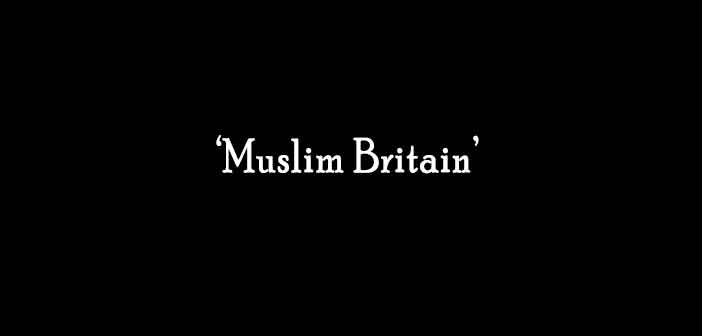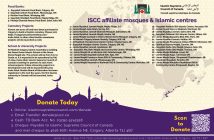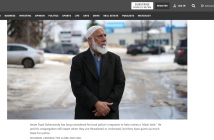“For every child who drifts into the moral relativism of contemporary Western values, another returns home with a belief in the revitalized form of Islam.’
Little was known of the Muslim presence in the UK until Rushdie’s literary disaster hit the bookstands in the 1980’s. Volatile images of angry Bradford Muslims burning copies of the book flooded the screens of homes throughout the world, creating a caricature of crazed extremist Muslims and not much else. A far cry from all things Islamic, the UK was commonly associated with the Queen, fish and chips and football hooliganism, an unlikely place for Muslims. Yet that is exactly what it is. Now called home to nearly two million Muslims1, the state of British Muslims since the wake of the Rushdie affair has been awe-inspiring.
The UK holds a diverse myriad of active Islamic organizations spanning from world class research bodies, Islamic universities, professional teacher training of Muslim student teachers, up to 75 Muslim schools and over 613 mosques. The change within pluralistic British society has been due to the disenchantment with the ideals the host society offered to Muslims. As a result, ‘more than half of Britain’s Muslims are now practicing, a significant increase when 10 years ago, only one fifth did.’2 It is precisely within this religious revival that I wish to discuss the sharp differences between Islam, culture and secular Britain that have proven to be the most significant milestones in the development of British Muslim youth.
Muslim Migration to the UK
There has been a Muslim presence in Britain for at least 300 years. The East India Company recruited seamen from Yemen, Gujarat, Assam and Bengal, known by the British as ‘lascars’, and a number of these created small settlements in port towns and cities in Britain. By 1842 three thousand lascars were visiting Britain. The small Yemeni population set up zawiyah’s (small prayer rooms), which were the settings for nikaah (marriage), aqikah (animal sacrifice and feasts for a newborn child), khitan (circumcisions) and janazah (funerals). One of the earliest imams was Sheikh Al Hakimi who died in 1934.3 Later in the 1920’s many South Asian seamen were recruited and who remained in the UK after World War II. The mass migration of Muslims to Britain took place during the 1950’s to the 70’s and mainly consisted of Muslims from South Asia. It was also during the 1970’s that large communities fromTurkey, the Middle East and North Africa migrated. Latterly, substantial Somali, Iranian, Arab and Bosnian communities have established themselves.
The new migrants took to manual labor positions during Britain’s industrial boom. Individuals from Pakistan, Bangladesh and India came in a steady flow to the industrial cities of the Midlands, Strathclyde and the textile towns of Yorkshire and Lancashire. Later, they dispersed to the more prosperous cities of London and the South East. The majority were lone male migrants and religious observance consisted of congregating at one another’s rented accommodation for Friday prayers. Whilst some faced a partial if not total lapse of religious observance – maintaining their cultural identities and rituals, others maintained their Muslim identity regardless of the negative social and moral challenges their new host society bought.
Many Muslim’s held the ‘myth-of-return’ to their home countries, with the intention of going back to Pakistan, India or Bangladesh once sufficient funds were raised in the UK. This hazy notion never became reality for the vast majority, who remained in the UK and eventually brought their families over to. It was when their families arrived, that Islam entered into the public sphere. As families grew, the issues of imparting religious education through the teaching of the Holy Qur’an, the basic beliefs and practices of Islam to their children needed to be addressed. This meant allocating a house for children’s education in the neighbourhood and using the same house for the five daily prayers. Muslim dietary laws saw the development of halal butcher shops and its requirement in mainstream British schools. Many Muslims encountered extremely negative responses from their local councils and fellow residents. However, regardless of the atmosphere in early Islamophobic Britain, the expansion of Muslim Britain had begun.
The development of the Mosque in Britain
It was only a matter of time that a house was proving to be too small a place to accommodate the ever-increasing number of Muslims. A mosque was needed. Notable mosques sprang up in Bradford in 1959. It was only until 1889 that Britain’s very first mosque was established in Woking, Surrey, which was funded by Shah Jehan, the ruler of Bhopal, India. It was in 1910 that leading members of the Muslim community joined forces and established a fund to establish the London Mosque Fund.4 In the early 40’s, another Muslim trust established the East London Mosque in Stepney, which later moved to Whitechapel. This mosque is still going strong today with a vibrant Muslim youth body that actively involve themselves in their community.
The landmark Regents Mosque was completed in 1977 in London. The site was donated by the British government in 1944 in response to the Egyptian governments donation of land for a church to the Anglican community in Cairo. Before 1964, only seven new mosques were registered in Britain, today the figure stands at some 613 of which 96% are purpose-built.5 It is precisely within these Mosques, earlier makeshift schools and homes that the next generation of Muslims were raised and educated in Islam.
Islam in Britain today
Britain’s practicing Muslim community is both a settled and established one. In the
mid 1990’s, researchers at the Policy Studies Institute asked a wide range of people about the importance of religion in their lives. Seventy four percent of the Muslim respondents said that religion was ‘very important.’ This compared with 45% of Hindus and Sikhs. Only 11% people ascribed themselves to the Church of England. Amongst Muslim men, over the age of 35, four in five reported that they visit a mosque at least once every week.’6Similarly, the state of the British Muslim youth shows a positive increase in religious observance. The new generation of Muslims do not have the barriers of communication that their elders may have had and are thus becoming more and more enterprising and expressive members of British society. A whole host of Muslim student organizations are the spring board from which young Muslims are learning about Islam: ‘The Muslim Student’s Society (1962), The Union of Muslim Organizations (1970), The Islamic Council of Europe (1973), Young Muslims (1984) Young Muslim Youth.’ 7
Muslim Youth
A sharp difference is becoming apparent between the younger and elder generations of Muslims, Islam and culture. An increasing number of youth are finding that there is a gap from what they have learnt from home about Islam and what they are learning at university. Many young Muslims feel a sense of agitation as they have indeed learnt how to read the Holy Qur’an and some have even, Alhamdulilaah, memorized it; yet they do not understand what it means. Consequently, the gradual ripping of the Holy Qur’an from the people has saw to the steady decline of illuminated individuals who act upon what they understand. Some university Islamic societies are inculcating an understanding of Islam based on research and active participation. Many organizations have understood this gap in service and have tried to meet the need by training their imams on the sensitive issues which bear upon the youth: education, marriage, role of parents and purpose of life, the dangers of the society they are living in and how best to practice Islam in, essentially, a non-Muslim setting.
This new generation, according to Zaki Badawi, (principal of the Muslim College in London) is ‘entering into the mainstream of British society whilst maintaining their Muslim identity. They accept Islamic prescriptions about modest dress but want that to be in a Western style. They want to eat Italian food, but it must be halal pizza.’ 8 Young Muslim girls can be seen sporting long dresses and scarves – adapting a modest style according to Islamic principles. Many universities house an Islamic society where regular Islamic seminars touch upon issues of Islamic history, Muslim identity in the West, Islamophobia, rights of Muslim women and education.
Many Muslim youth seem to shy away from what they term the ‘old-school’ of teaching Islam: ‘Being told about Islam whilst being shouted, about the Day of Judgment are subjects which are important for me to know but the style of delivery is something which needed to be changed.’ This has given rise to speakers who appeal to the youth who advise them on Islam in a humorous style. “The first generation followed the letter of the law of Islam; the second generation is either searching for the spirit of the law or has abandoned it altogether. The tragedy of the older generations approach is that they have created an image of Islam which is easy for young people to reject,’9 says 22 year old Sadia Irfan. Far from ridiculing their parents, many British Muslim youth are choosing to find out about Islam for themselves whilst appreciating and honoring the strong bond they hold with their elders. Many young Muslim’s take it upon themselves to set up stalls with leaflets about Islam and give daw’ah in the middle of a busy city street to anyone who is interested or willing to stop and listen.
In essence, young British Muslims are becoming clearer about their religious identity, having gained a more sharpened understanding of what Islam is about and how to apply it in their lives. Parents are finding that their children are coming back from university sporting the hijab or with a beard. Some youth have found that their parents are wary of their newfound zeal as chronicled in the play ‘My son, the Fanatic.’ The play explores the life of a young Muslim of Pakistani/Caucasian parentage who leaves home for university, returning to help his family onto the path of Islam. He finds that his father has assimilated to Western culture and sets about trying to make him change. It is a story of the backlash of assimilation to British society which will simply not do for some young Muslims: ‘Before there were two choices: assimilate or remain in a South Asian identity. We in the next generation did not feel at home in either the Western culture or in that of our parents homeland, when we visited it, was not like the utopia, the golden land. We now have a third option. To be a British Muslim,’ says Jamil Ali.
Interweaving Islam and Cultural Identity
Many Muslim families have cleverly assimilated Muslim ideals without losing their rich culture. One particular family found their son married to a white convert to Islam, packing his bags to learn Arabic and Islamic mysticism inDamascus, whilst another teaches their youth Urdu to master the great contribution Allama Iqbal had to make to the understanding of Islam.
An Egyptian family took their daughters back to Egypt to realize the richness of their early Muslim culture, only to find their ‘modern’ Egyptian family were amazed that these girls refused to shake hands with non-mahram members of the family, stating that this was unnecessary contact and against Islamic Shar’iah. They were taken aback that these young Muslim’s were from England and actually practiced Islam. All these families benefited and both lead rich lives within Islamic principles yet the latter two did so with the added benefit of experiencing the beauty of their Muslim culture.
Despite the richness of culture of British Muslim youth, many they find themselves in a cultural vacuum where they may not find themselves having anything in common with someone from their country of origin but more with a convert to Islam. Hence, a fusion of Islam without attachment to any one particular culture has created a whole new identity and a new generation of Muslims.
Parents
Parents have played a great part in maintaining their children’s Muslim identity in a non-Islamic civilization. The younger generations potential to succeeding as a Muslim is largely based according to their background encompassed within their education; upbringing; psychological; emotional make-up and intellectual capabilities. Of course the inherent nature of the child (fitra) plays the major role, as was the case of Amna Aziz. Born to a white mother and Egyptian father, Amna was hardly versed on the principles of Islam. Only when she attended Islamic awareness sessions held at a London university did she come to fully appreciate Islam. After embracing Islam, she returned to her parent’s home in Wales. Surprisingly, it was her mother who accepted her newfound zeal, yet her father shunned her for not assimilating to the British standard. This clearly shows that against all odds, how a child can still remain inclined towards Islam regardless of their background. Allah (swt) guides whom He pleases.
The other side of the coin …
The UK has its fair share of negative examples too. A sub-culture of youth whose parents are from the Islamic faith is following the consumer individualistic standard. Pandering to the ideals churned out by the media standard is commonplace. Many do not wish to follow Islam out of choice or simply because their parents have not placed great emphasis of Islam in their lives.
The vices available in North America are equally available in England; drink, drugs and relationships are apparent with a column of society, who when questioned, do not identify themselves with any culture or religion. The aftermath and results are of course, horrifying; a following generation with no ideals and who respond to the fitful stops and starts of the latest female/male ideal in the media frenzied society, living out their lives in the shopping malls. Culture is limited to the attendance of non-Islamic ‘mela’s’, which only serves to corrupt the mind of the youth furthermore. Anything close to religious observance is limited to Eid prayers and in extreme cases, not even that.
Responding to the needs of Muslim Youth
Many British Muslims have responded to the needs of the time for the Muslim youth, essentially the next generation of Muslim parents. Muslim youth workers are available to the youth and many mosques are realizing that a youth committee is a vital component in attracting the younger generation towards Islam. Providing activities such as spiritual camps, sports events on the local and national level, Islamic awareness talks and a youth magazine are some of the methods, which have proved effective.
The provision of education from the kinder-garden level to senior high school level has proved to be one of the realistic methods to curb the negative effects public schooling has on the youth of today. Many parents realize that by allowing a child to be fed the idea’s of a non-Muslim through public education for up to an average of thirty-two hours in any given week, will not maximize the Muslim child’s potential. Over 75 Muslim schools have been set up, with exemplary records of achievement. Yusuf Islam’s (formerly Cat Stevens) Islamia School in North London is considered to be one of the best Muslim schools in the UK.
Alhamduliaah, many youth are in fact doing their best to follow Islam within the UK and are a source of appreciation and thankfulness to Allah (swt.) The disenchantment of what western values have to offer has produced a transition generation who if they had not already, are now returning to Islam. The vitality and spiritual richness of the Muslim community has not gone unnoticed, as Prince Charles noted at a speech at the Wilton Park Seminar: ‘We in the western world seem to have lost a sense of wholeness. It is a battle to restore an understanding of the spiritual integrity of our lives, and for reintegrating what the modern world has fragmented. Islamic culture in its traditional form has striven to preserve this integrated spiritual view of the world in a way we have not seen fit to do in recent generations in the west. Everywhere in the world people seemingly want to learn English. But we in the West, in turn, need to be taught by Islamic teachers how to learn once again with our hearts as well as our heads.’ 10
In sum, the imaginative methods used by the British Muslim society to fire the enthusiasm of the youth have produced a generation detached from secular Western values. The challenges thrown at Muslim youth have only strengthened the Muslims youth’s resolve – thanks to Allah (swt) alone, that they are finding the answers they need in their Din.






